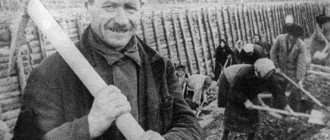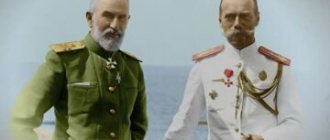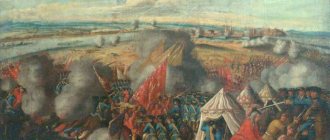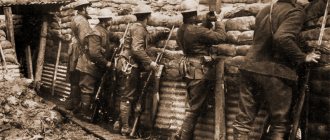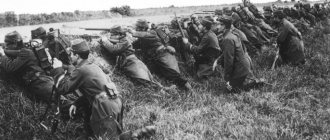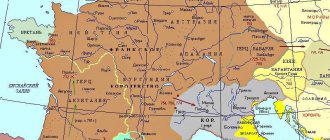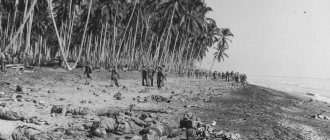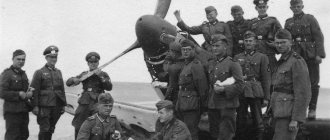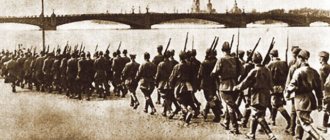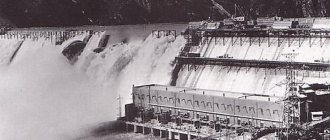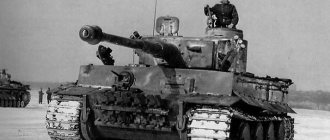In terms of its significance, the Battle of Molodi is comparable to Kulikovo and other key battles in Russian history. Victory in the battle allowed Russia to maintain its independence and became a turning point in the confrontation between the Muscovite state and the Crimean Khanate, which abandoned its claims to the Kazan and Astrakhan khanates and henceforth lost most of its power.
In 1552, the Russian army took Kazan, and four years later, in an effort to gain access to the Caspian Sea, they succeeded in conquering the Astrakhan Khanate. Both of these events caused a very negative reaction in the Turkic world, since the fallen khanates were allies of the Ottoman Sultan and his Crimean vassal. In addition, new spaces opened up for the Moscow state for political and trade expansion to the south and east, and the ring of hostile Muslim khanates that had constrained Rus' for several centuries was broken. Offers of citizenship from the mountain and Circassian princes were not slow to follow, and the Siberian Khanate recognized itself as a tributary of Moscow.
This development of events greatly worried the Ottoman Empire and the Crimean Khanate. The raiding economy, which made up the majority of the economy of the Crimean state, came under threat as Muscovite Rus' strengthened. The Sultan was concerned about the prospects of stopping the supply of slaves and booty from the southern Russian and Ukrainian lands, as well as the safety of the Crimean vassals. The goal of Ottoman and Crimean policy was to return the Volga region to the orbit of Ottoman interests and restore the former ring around Muscovite Rus'.
↑ Livonian War
Encouraged by his success in reaching the Caspian Sea, Ivan the Terrible intended to win access to the Baltic Sea, since the isolation of the Moscow state was largely due to its geographical isolation from the main trade routes and centuries-old lack of access to the sea.
In 1558, the Livonian War began against the Livonian Confederation, which was later joined by Sweden, the Grand Duchy of Lithuania and Poland. At first, events developed well for Moscow: under the attacks of the troops of princes Serebryany, Kurbsky, and Adashev in 1561, the Livonian Confederation was defeated, most of the Baltic states came under Russian control, and the ancient Russian city of Polotsk, in which one of the oldest Orthodox dioceses was located, was recaptured.
Soon, however, luck gave way to a series of defeats. In 1569, as a result of the Union of Lublin, the position of the Moscow state became more complicated, since it had to withstand the increased strength of its rivals. Taking advantage of the presence of most of the Russian troops in the Baltic states, and the tense internal situation associated with the introduction of the oprichnina, the Crimean Khan made numerous raids on the southern borders of Moscow lands, including an unsuccessful campaign against Astrakhan.
XVI century – birth of the Russian Empire
The 16th century is the most important period in the history of our country. During the reign of Ivan III, the creation of a unified Russian state was completed; the Principality of Tver, Veliky Novgorod, Vyatka Land, part of the Principality of Ryazan and other territories were annexed to it. The Moscow state finally went beyond the borders of the lands of North-Western Rus'. The Great Horde was finally defeated, and Moscow declared itself its heir, thus declaring its Eurasian claims for the first time.
The heirs of Ivan III continued his policy of further strengthening the central government and collecting the surrounding lands. Ivan IV, whom we better know as Ivan the Terrible, achieved particular success in this last issue. The period of his reign is a turbulent and controversial time, about which historians continue to argue even after more than four centuries. Moreover, the figure of Ivan the Terrible itself evokes the most polar assessments... However, this is not directly related to the topic of our story.
Moscow Streltsy and their conventional weapons
Ivan the Terrible carried out a successful military reform, thanks to which he was able to create a large combat-ready army. This in many ways allowed him to significantly expand the borders of the Moscow state. The Astrakhan and Kazan Khanates, the lands of the Don Army, the Nogai Horde, Bashkiria, and Western Siberia were annexed to it. By the end of the reign of Ivan IV, the territory of the Moscow state doubled and became larger than the rest of Europe.
Believing in his own strength, Ivan IV began the Livonian War, victory in which would have guaranteed Muscovy free access to the Baltic Sea. This was the first Russian attempt to “open a window to Europe.” Alas, it was not successful. The fighting proceeded with varying degrees of success and dragged on for 25 years. They exhausted the Russian state and led to its decline, which another force did not fail to take advantage of - the Ottoman Empire and its vassal Crimean Khanate - the westernmost fragment of the disintegrated Golden Horde.
The Crimean Tatars have been one of the main threats to Russian lands for centuries. As a result of their regular raids, entire regions were devastated, tens of thousands of people fell into slavery. By the time of the events described, the regular robbery of Russian lands and the slave trade had become the basis of the economy of the Crimean Khanate.
By the mid-16th century, the Ottoman Empire had reached the height of its power, stretching across three continents, from Persia to Algeria and from the Red Sea to the Balkans. It was rightfully considered the largest military power of that time. The Astrakhan and Kazan Khanates were part of the interests of the Sublime Porte, and their loss did not suit Istanbul at all. Moreover, the conquest of these lands opened up new routes for expansion for the Moscow state - to the south and east. Many Caucasian rulers and princes began to seek the patronage of the Russian Tsar, which the Turks liked even less. The further strengthening of Moscow could pose a direct threat to the Crimean Khanate. Therefore, it is not surprising that the Ottoman Empire decided to take advantage of the weakening of Muscovy and take from Tsar Ivan the lands he conquered in the Kazan and Astrakhan campaigns. The Turks wanted to get back the Volga region and restore the “Turkic” ring in southeast Russia.
At this time, most and the best part of the Russian military forces were on the “western front”, so Moscow immediately found itself at a disadvantage. Roughly speaking, Russia got a classic war on two fronts. After the signing of the Union of Lublin, the Poles also joined the ranks of its opponents, which made the position of the Russian Tsar almost hopeless. The situation within the Moscow state itself was also very difficult. The oprichnina devastated the Russian lands, sometimes worse than any steppe inhabitants; to this we can add a plague epidemic and several years of crop failure, which caused famine.
In 1569, Turkish troops, together with the Tatars and Nogais, already tried to take Astrakhan, but were not successful and were forced to retreat with heavy losses. Historians call this campaign the first of a series of Russian-Turkish wars that would last until the beginning of the 19th century.
↑ Crimean raid on Moscow in 1571
With the support of the Ottoman Empire and in agreement with the newly formed Polish-Lithuanian Commonwealth, the Crimean Khan Devlet Giray in May 1571, with an army of 40 thousand, made a devastating campaign against Russian lands.
Having bypassed the abatis lines on the southern outskirts of the Russian kingdom with the help of defectors (a chain of fortifications called the “belt of the Most Holy Theotokos”), he reached Moscow and set fire to its suburbs. The city, built mainly of wood, was almost completely burned down, with the exception of the stone Kremlin. The number of victims and those taken captive is very difficult to determine, but, according to various historians, it amounts to tens of thousands killed and more than 150 thousand dead. After the fire of Moscow, Ivan IV, who had previously left the city, offered to return the Astrakhan Khanate and was almost ready to negotiate the return of Kazan, and also tore down fortifications in the North Caucasus.
However, Devlet Giray was sure that Rus' would not recover from such a blow and could itself become an easy prey, moreover, famine and a plague epidemic reigned within its borders. In his opinion, all that remained was to strike the final blow. For the entire year after the campaign against Moscow, he was engaged in forming a new, much larger army. The Ottoman Empire provided active support, providing him with 40 thousand soldiers, including 7 thousand selected Janissaries. He managed to gather about 80 thousand people from the Crimean Tatars and Nogais. Owning a huge army of 120 thousand people at that time, Devlet Giray moved towards Moscow. The Crimean Khan repeatedly stated that he was “going to Moscow to rule.” The lands of Muscovite Rus' were already divided in advance between the Crimean Murzas. The invasion of the Crimean army, as well as Batu’s campaigns of conquest, raised the acute question of the existence of an independent Russian state.
Vorotynsky's trick
At this time, the commander-in-chief of the Russian troops, near the village of Molod, established a walk-city, reliably fortified by the Rozhaika River. D. Khvorostinin led his pursuers there. The Crimean army came under fire from cannons and arquebuses from Gulyai-Gorod. There were much more Tatars than Russians, but the defense was not broken through. The battle began to drag on.
On July 31, Tebedey-Murza, who commanded the vanguard of the Tatar army, dies. On August 1, Suzdal resident Temir-Ivan Shibaev captured Divey-Murza, one of the most important people under the Crimean Khan. They also captured one of the sons of the khan himself.
Devlet-Girey did not know one thing: the soldiers defending the Gulyai-city had neither food nor water, holding on only by slaughtered horses. But this was unknown to the Crimean Khan, who wanted to quickly end the battle.
The outcome of the battle was predetermined by the risky maneuver conceived by Vorotynsky. When the battle was going on, on August 2, a large regiment secretly left Gulyai-Gorod and, bypassing the Tatars, stood in their rear, waiting for a signal. Artillery burst out, and the regiments of Khvorostinin and the German Reiters who took part in the battle came out of the defense. At this time, the hiding regiment struck the rear of the Tatar army. Khan thought that the Russians had received reinforcements. The Turkish-Crimean army fled, leaving behind the dead and weapons.
↑ On the eve of the battle
The head of the border guard in Kolomna and Serpukhov, which consisted of only 20 thousand soldiers, was Prince Mikhail Vorotynsky.
Under his leadership the oprichnina and zemstvo troops were united. In addition to them, a detachment of 7 thousand German mercenaries sent by the tsar, as well as Don Cossacks, joined Vorotynsky’s forces. A hired detachment of thousands of “Kaniv Cherkasy”, that is, Ukrainian Cossacks, arrived. Vorotynsky received instructions from the Tsar on how to behave in case of two scenarios. In case Devlet Giray moved to Moscow and sought battle with the entire Russian army, the governor was obliged to block the old Muravsky Way for the khan and rush to the Zhizdra River. If it became obvious that the Crimeans were interested in the traditional quick raid, robbery and equally quick retreat, Vorotynsky was to set up ambushes and organize “partisan” actions. Ivan the Terrible himself, as last year, left Moscow, this time towards Veliky Novgorod.
This time the Khan's campaign was incomparably more serious than an ordinary raid. On July 27, the Crimean-Turkish army approached the Oka and began to cross it in two places - at the confluence of the Lopasny River into it along the Senkin Ford, and upstream from Serpukhov. The first crossing point was guarded by a small guard regiment of “children of the boyars” under the command of Ivan Shuisky, consisting of only 200 soldiers.
The 20,000-strong Nogai vanguard of the Crimean-Turkish army under the command of Tereberdey-Murza attacked him. The detachment did not take flight, but entered into an unequal battle, but was scattered, however, managing to inflict great damage on the Crimeans. After this, Tereberdey-Murza’s detachment reached the outskirts of modern Podolsk near the Pakhra River and, having cut all the roads leading to Moscow, stopped waiting for the main forces.
The main positions of the Russian troops, reinforced by Gulyai-gorod, were located near Serpukhov. Gulyai-Gorod consisted of half-a-log shields the size of a log house wall, mounted on carts, with loopholes for shooting, and arranged in a circle or in a line.
Russian soldiers were armed with arquebuses and cannons. To distract, Devlet Giray sent a detachment of two thousand against Serpukhov, while he himself with the main forces crossed the Oka River in a more remote place near the village of Drakino, where he encountered the regiment of governor Nikita Odoevsky, which was defeated in a difficult battle. After this, the main army moved towards Moscow, and Vorotynsky, having removed his troops from coastal positions, moved after him.
This was a risky tactic, since all hope was placed on the fact that by “grabbing the tail” of the Crimean army, the Russians would force the khan to turn around for battle and not go to defenseless Moscow. However, the alternative was to overtake the Khan along a side route, which had little chance of success. In addition, there was the experience of the previous year, when the governor Ivan Belsky managed to arrive in Moscow before the Crimeans, but could not prevent it from being set on fire.
What did the Russians have?
The number of Russian forces near Moscow was several times smaller than the invaders. Most of the tsarist army was in the Baltic states or defending the western borders of the state. Prince Vorotynsky was supposed to repel the enemy onslaught; it was him who the tsar appointed as commander-in-chief. Under his command were about 20 thousand soldiers, who were later joined by a detachment of German mercenaries (about 7 thousand soldiers), Don Cossacks and a thousand Zaporozhye Cossacks (“Kaniv Cherkasy”) under the leadership of Colonel Cherkashenin. Ivan the Terrible, as in 1571, when the enemy approached Moscow, took the treasury and fled to Novgorod.
Mikhail Ivanovich Vorotynsky was an experienced military leader who spent almost his entire life in battles and campaigns. He was the hero of the Kazan campaign, where the regiment under his command repelled an enemy attack, and then occupied part of the city wall and held it for several days. He was a member of the Tsar's Near Duma, but then fell out of favor - he was suspected of treason, but saved his head and got away with just exile. In a critical situation, Ivan the Terrible remembered him and entrusted him with command of all available forces near Moscow. The prince was helped by the oprichnina governor Dmitry Khvorostinin, who was fifteen years younger than Vorotynsky. Khvorostinin proved himself during the capture of Polotsk, for which he was noted by the tsar.
In order to somehow compensate for their small numbers, the defenders built a walk-city - a specific fortification structure consisting of coupled carts with wooden shields. The Cossacks were especially fond of this type of field fortification; Walk-Gorod made it possible to reliably protect infantry from cavalry attacks. In winter, this fortification could be made from sleighs.
Walk-city.
Traditional Cossack fortification. Documents have been preserved that allow us to determine the size of Prince Vorotynsky’s detachment with an accuracy of one soldier. It amounted to 20,034 people. Plus a detachment of Cossacks (3-5 thousand soldiers). We can also add that the Russian troops had squeaks and artillery, and this subsequently played a crucial role during the battle.
↑ Progress of the battle
The Crimean army was fairly stretched out and while its advanced units reached the Pakhra River, the rearguard was only approaching the village of Molodi, located 15 kilometers from it.
It was here that he was overtaken by an advanced detachment of Russian troops under the leadership of the young oprichnina governor, Prince Dmitry Khvorostinin. A fierce battle broke out, as a result of which the Crimean rearguard was practically destroyed. This happened on July 29. After this, what Vorotynsky hoped for happened. Having learned about the defeat of the rearguard and fearing for his rear, Devlet Giray deployed his army. By this time, a walk-city had already been developed near Molodei in a convenient location, located on a hill and covered by the Rozhaya River. Khvorostinin’s detachment found itself face to face with the entire Crimean army, but, having correctly assessed the situation, the young governor was not at a loss and lured the enemy to Walk-Gorod with an imaginary retreat.
With a quick maneuver to the right, taking his soldiers to the side, he brought the enemy under deadly artillery and squeal fire - “many Tatars were beaten.” In Gulyai-Gorod there was a large regiment under the command of Vorotynsky himself, as well as the Cossacks of Ataman Cherkashin who arrived in time. A protracted battle began, for which the Crimean army was not ready. In one of the unsuccessful attacks on Gulyai-Gorod, Tereberdey-Murza was killed.
After a series of small skirmishes, on July 31, Devlet Giray launched a decisive assault on Gulyai-Gorod, but it was repulsed. His army suffered heavy losses, including the capture of the adviser to the Crimean Khan, Divey-Murza. As a result of large losses, the Crimeans retreated. The next day the attacks stopped, but the position of the besieged was critical - there were a huge number of wounded in the fortification, and the water was running out.
On August 2, Devlet Giray again sent his army to attack. In a difficult struggle, up to 3 thousand Russian archers were killed defending the foot of the hill at Rozhaika, and the Russian cavalry defending the flanks also suffered serious losses. But the attack was repulsed - the Crimean cavalry was unable to take the fortified position.
In the battle, the Nogai Khan was killed, and three Murzas died. And then the Crimean Khan made an unexpected decision - he ordered the cavalry to dismount and attack the Gulyai-city on foot together with the Janissaries. The climbing Crimeans and Ottomans covered the hill with corpses, and the Khan threw in more and more forces.
Approaching the plank walls of the walk-city, the attackers cut them down with sabers, shook them with their hands, trying to climb over or knock them down, “and here they beat many Tatars and cut off countless hands.” Already in the evening, taking advantage of the fact that the enemy was concentrated on one side of the hill and carried away by the attacks, Vorotynsky undertook a bold maneuver.
Having waited until the main forces of the Crimeans and the Janissaries were drawn into a bloody battle for Gulyai-Gorod, he quietly led a large regiment out of the fortification, led it through a ravine and struck in the rear of the Crimeans. At the same time, accompanied by powerful volleys of cannons, Khvorostinin’s warriors made a sortie from behind the walls of the city. Unable to withstand the double blow, the Crimeans and Turks fled, abandoning their weapons, carts and property. The losses were enormous - all seven thousand Janissaries, most of the Crimean Murzas, as well as the son, grandson and son-in-law of Devlet Giray himself were killed. Many high Crimean dignitaries were captured.
During the pursuit of the foot Crimeans to the crossing of the Oka River, most of those who fled were killed, as well as another 5,000-strong Crimean rearguard left to guard the crossing. No more than 10 thousand soldiers returned to Crimea.
As the Novgorod Chronicle reported:
Yes, that month of August 6 on Wednesday, the sovereign’s joy, they brought Crimean bows and two sabers and saadachki arrows to Novgorod... and the Crimean Tsar came to Moscow, and with him were his 100 thousand and twenty, and his son Tsarevich, and his grandson, yes his uncle, and the governor Diviy Murza - and God help our Moscow governors over the Crimean power of the tsar, Prince Mikhail Ivanovich Vorotynsky and other governors of the Moscow sovereign, and the Crimean tsar fled from them inappropriately, not on any path, not on roads, in a small squad; and our commanders of the Crimean Tsar killed 100 thousand on Rozhai on the rivers, near Resurrection in Molody, on Lopasta, in the Khotyn district, there was a case with Prince Mikhail Ivanovich Vorotynsky, with the Crimean Tsar and his governors... and there was a case from Moscow fifty miles away.
Consequences of the battle
In this battle, almost all the Janissaries, many Nogais and Tatars died, among whom were the Khan’s son, grandson and son-in-law. Everything that was in the Crimean convoy was captured by the Russians, and the khan fled, leaving a small detachment in the swamps as a diversion. Pursuing the defeated Tatars, Russian troops reached the Oka. Many of those who fled died during the crossing. No more than 15 thousand people reached Crimea. Not a single warrior returned to Turkey.
The Battle of Molodin is of great importance, because at that time Rus' could barely stand on its feet due to hunger and ruin. Despite the ongoing Livonian War, the Russian people defended their capital, and for a long time eliminated threats from the Turks and Crimean Tatars.
Russia survived as a state and saved Western Europe from Turkish expansion
If Devlet-Girey had won at Molodi, his victory would have been much more significant than in 1571. The Russians would not have any troops left to defend Moscow, which, moreover, had not yet had time to rebuild after last year’s fire. On the ruins of defenseless Moscow, the Crimean Khan could dictate any terms of peace to Russia. For an indefinite period, the Crimean (indirect Ottoman) yoke would be established over Russia.
At the same time, Russia would have to stop all struggle for the Baltic states. The Polish and Swedish kings could also present any demands to Russia. It is possible that Russia would have lost not only the Volga region (given to the Crimeans), but also Novgorod and Pskov. Simply put, the Russian state could cease to exist.
Russia's victory at Molodi also had international significance. The establishment of a Crimean protectorate over the Volga region would mean an unprecedented strengthening of Turkey, which was already at the zenith of its power. Türkiye would then have good prospects for further expansion into Christian states in Europe.
Consequences of the Battle of Molodi
What were the consequences of the battle of Molodi, why do modern researchers put this battle on a par with Kulikovskaya and Borodino? Here are the main ones:
- The defeat of the invaders on the outskirts of the capital probably saved Moscow from repeating the devastation of 1571. Tens, or even hundreds of thousands of Russians were saved from death and captivity;
- The defeat at Molodi discouraged the Krymchaks from launching raids on the Moscow state for almost twenty years. The Crimean Khanate was able to organize the next campaign against Moscow only in 1591. The fact is that the majority of the male population of the Crimean Peninsula took part in large raids, a significant part of which was slaughtered from Molodei;
- The Russian state, weakened by the Livonian War, oprichnina, famine and epidemics, received several decades to “lick its wounds”;
- The victory at Molodi allowed Moscow to retain the Kazan and Astrakhan kingdoms, and the Ottoman Empire was forced to abandon plans to return them. In short, the Battle of Molodi put an end to the Ottoman claims to the Volga region. Thanks to this, in the next centuries the Russians will continue their expansion to the south and east (“meeting the sun”) and reach the shores of the Pacific Ocean;
- After the battle, the borders of the state on the Don and Desna were moved several hundred kilometers further south;
- The victory at Molodi showed the advantages of an army built on a European model;
- However, the main result of the victory at Molodi is, of course, the preservation of sovereignty and full international subjectivity by the Moscow state. In case of defeat, Moscow in one form or another would have become part of the Crimean Khanate and entered the orbit of the Ottoman Empire for a long time. In this case, the history of the entire continent would have taken a completely different path. It would not be an exaggeration to say that in the summer of 1572, on the banks of the Oka and Rozhaika, the question of the very existence of the Russian state was being decided.
The fate of the main creator of the glorious “Victoria” under Molodi, Prince Vorotynsky, was sad. Soon he fell into disgrace again, was accused of treason and “ended up in the basement,” where Tsar Ivan himself personally tortured him. The governor survived the interrogations and was sent into exile, but died of his wounds along the way.
A memorial sign at the site of the Battle of Molodi
Interest in the Battle of Molodi began to be revived only at the end of the 20th century, at which time the first serious studies on this topic appeared. It is surprising why this absolutely real historical event has not yet been properly reflected in Russian popular culture.
